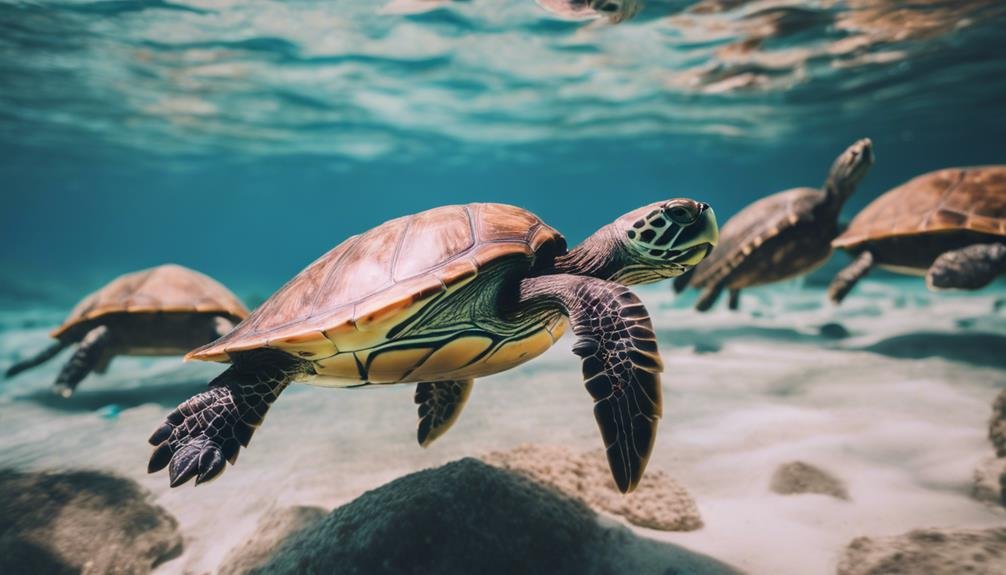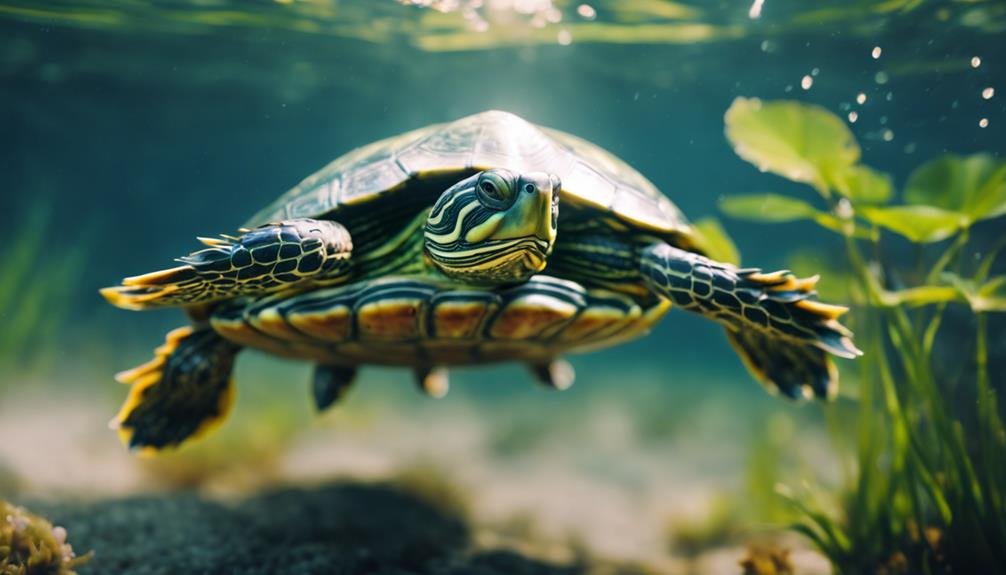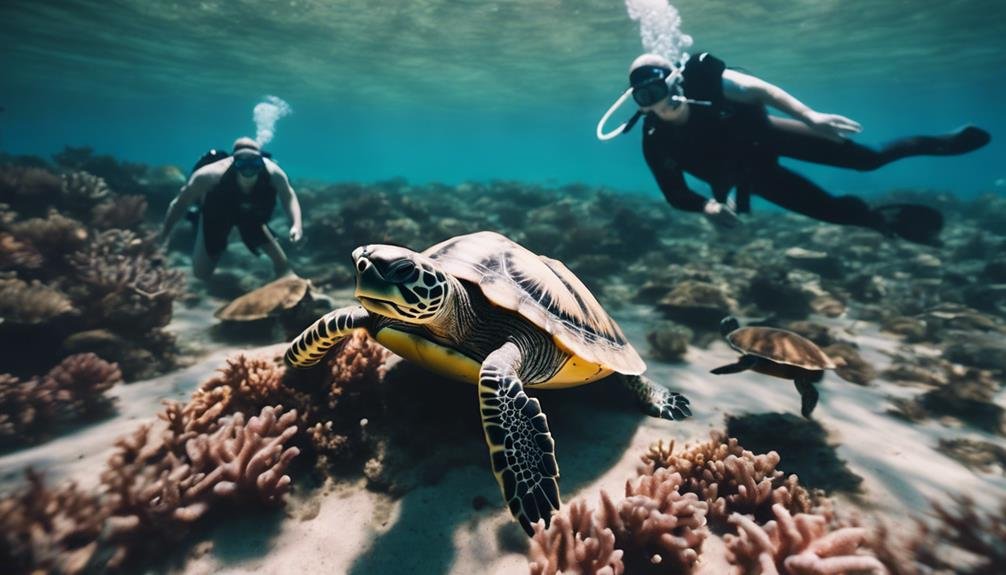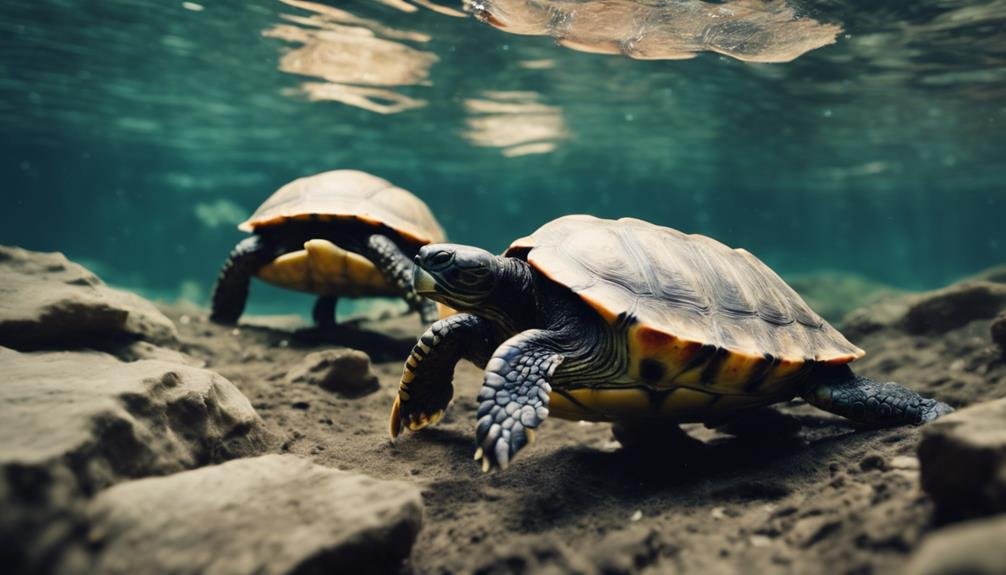You might think all turtles are natural swimmers, but you’d be surprised to learn that’s not the case. While aquatic turtles glide through water with ease, thanks to their webbed feet and streamlined shells, their terrestrial cousins, like tortoises, don’t share this ability. Their bulkier, heavier shells make swimming a challenge, if not impossible, for them. This distinction highlights the incredible diversity within the turtle species, adapted over millennia to thrive in varying habitats. If you’re curious about which turtles can defy your expectations and which ones stay grounded, you’ll find the nuances in their abilities and behaviors fascinating.
Key Takeaways
- Not all turtles can swim; terrestrial turtles like tortoises struggle due to heavy shells.
- Aquatic turtles are efficient swimmers with streamlined bodies and webbed feet.
- Semi-aquatic turtles, such as red-eared sliders, are adapted to both land and water environments.
- Box turtles, preferring land habitats, have limited swimming abilities and avoid deep water.
- Sea turtles are adept swimmers, spending most of their lives in the ocean but return to land for nesting.
Common Misconceptions
One common misconception is that all turtles can swim, but this isn’t the case, as some species lack the necessary adaptations for swimming. You might think that every turtle you come across can easily take to water, but that’s far from the truth. Different types of turtles have varying swimming abilities, largely influenced by their physical characteristics and natural habitats.
For instance, turtles that can swim, like sea turtles, have streamlined shells and webbed feet, making them adept at moving through water. These adaptations allow them to glide effortlessly, responding well to changes in water temperature and currents.
On the other hand, land-dwelling turtles, such as tortoises, are built differently. They don’t possess these aquatic adaptations and are better suited to a life on solid ground. Even among turtles that can handle some water, like box turtles, their swimming capabilities aren’t as advanced. They might manage short distances in calm waters but don’t expect them to exhibit the grace of their sea-dwelling cousins.
Understanding these differences is important, as it impacts how you care for them, especially in relation to their environment and exposure to water.
Aquatic Vs. Terrestrial Turtles
You might think all turtles can swim, but there’s more to it when you compare aquatic and terrestrial turtles.
While aquatic turtles excel in water with their streamlined bodies, terrestrial turtles often find swimming a challenge due to their heavy shells.
Understanding these differences is essential for providing the right care and habitat for each type.
Habitat Preferences Explained
Turtles showcase a fascinating diversity in habitat preferences, with aquatic species like sea turtles thriving in water, while terrestrial ones such as tortoises prefer the dryness of land. This difference isn’t just about where they live; it’s rooted in their physical make-up.
Aquatic turtles have webbed feet or even flippers, designed for slicing through water with ease. Their shells are streamlined, cutting down resistance as they swim. On the flip side, terrestrial turtles boast claws perfect for digging and walking on the rugged terrain. Their domed shells offer protection against predators on land.
Swimming Abilities Compared
While aquatic turtles glide through water with ease, terrestrial counterparts, like tortoises, often find swimming a challenging task.
Aquatic turtles, such as sea turtles, are built for the water with streamlined bodies, flipper-like limbs, and hydrodynamic shells that enable them to swim efficiently. They spend most of their lives in the aquatic domain, exhibiting behaviors specialized for swimming, diving, and foraging underwater.
On the flip side, terrestrial turtles have heavy, dome-shaped shells and clawed feet, not designed for swimming. They’re primarily land-dwellers, relying on strong limbs for walking and digging rather than swimming. Although all turtles can move in water to some extent, their swimming capabilities vary greatly.
Aquatic turtles excel in aquatic environments, while terrestrial turtles are better suited for life on land.
Care Requirements Differ
Understanding the specific care requirements for aquatic and terrestrial turtles is crucial to guarantee their health and happiness. Whether your shelled friend is a little red slider or a years-old tortoise, it’s a good idea to know what they need.
| Aspect | Aquatic Turtles | Terrestrial Turtles |
|---|---|---|
| Environment | Water with filtration, basking area | Land-based, varied terrain |
| Adaptations | Webbed feet, streamlined bodies | Lack swimming adaptations |
| Diet | Aquatic plants, insects, small fish | Leafy greens, vegetables, fruits |
| Swimming Ability | Efficient swimmers | Not efficient or unable to swim |
| Habitat Preference | Prefer water environments | Rely on land habitats |
Tailoring their habitat and diet to these specifics ensures they thrive.
The Box Turtle Exception
Despite their ability to float, box turtles aren’t designed for the swimming life. Unlike their aquatic relatives, box turtles are pretty much land lovers. They spend the majority of their time on terra firma, where they’re most at ease. Their bodies are a reflection of this preference, with shells that are far from streamlined, making swimming an inefficient and likely exhausting endeavor.
These terrestrial creatures may occasionally wade into shallow waters to cool off or hydrate, but don’t expect them to dive deep or swim gracefully. Their paddling might look endearing, but it’s far from the powerful strokes of aquatic turtles. Box turtles’ habitat choices reflect their limited swimming capabilities. They thrive in environments that offer moist soil and lush vegetation, not open water. This preference ensures they remain in areas where their needs are met without the necessity of becoming proficient swimmers.
Understanding box turtles’ natural inclinations and physical limitations helps in providing them with a suitable environment that mimics their wild habitats. It’s clear they’re not built for the swimming life, and their lifestyle pretty much revolves around the land, where they’re happiest and most at home.
Swimming Skills and Species


Sea turtles, with their streamlined bodies and flipper-like limbs, excel in swimming, showcasing the vast differences in aquatic abilities among turtle species. You might be surprised to learn that not every single turtle species shares this proficiency. While sea turtles glide through the ocean with ease, their freshwater counterparts, like painted turtles and red-eared sliders, rely on their webbed feet for a different style of navigation. These species can swim well but don’t mistake their ability for that of their sea-dwelling cousins.
As you explore further into the turtle world, you’ll find that land-dwelling tortoises are a whole different story. Unlike their aquatic relatives, tortoises aren’t built for swimming. They may manage to stay afloat thanks to buoyancy, but it’s clear they’re out of their element in deep water. This distinction is important to make sure you’re providing the right environment for each species.
Understanding the swimming capabilities of each turtle species is essential, not just for their well-being but also for their conservation. It’s crucial to tailor care and protection efforts to their specific needs, ensuring every single one has the chance to thrive in its natural or adopted habitat.
Dangers of Wrong Assumptions
One common mistake is assuming all turtles can swim, which can lead to serious risks for those adapted to life on land. While many turtles are indeed adept swimmers, some species, like tortoises, aren’t designed for aquatic life. These terrestrial turtles can face dire consequences if placed in water, as their bodies aren’t built to navigate or stay afloat in deep water.
To avoid putting these creatures in peril, it’s important to recognize the diversity among turtle species and their specific needs and capabilities.
Here are four key points to remember:
- Not all turtles are swimmers: Acknowledge the differences between species and their natural habitats.
- Tortoises are at risk in water: Their body structure isn’t meant for swimming, posing a drowning risk in deep water.
- Incorrect assumptions lead to danger: Assuming swimming ability without knowledge can endanger a turtle’s life.
- Research is essential: Before making assumptions about a turtle’s ability to swim, it’s important to research its specific species characteristics.
Understanding these points helps promote the safety and well-being of turtles by respecting their natural abilities and limitations.
Habitat Preferences


As you explore the world of turtles, you’ll find they’re not all the same when it comes to where they call home. Some are water lovers, thriving in oceans or freshwater systems, while others split their time between aquatic and terrestrial environments.
The climate also plays a significant role in shaping their habitats, affecting where these fascinating creatures can live and thrive.
Varied Natural Environments
Turtles exhibit a wide range of habitat preferences, from freshwater lakes to the vast ocean, depending on their species. This diversity in living environments underscores their adaptability and the varied ecological roles they play.
Here’s a closer look at the environments some turtles call home:
- Sea Turtles: They primarily live in the ocean, traveling vast distances, but uniquely return to land to lay their eggs.
- Freshwater Turtles: These turtles prefer the calm waters of ponds, lakes, rivers, and streams, thriving in areas with abundant food and nesting sites.
- Softshell Turtles: Favoring sandy or muddy bottoms, they excel in camouflage and ambush their prey from these concealments.
- Box Turtles: Unlike their aquatic counterparts, box turtles are land dwellers, inhabiting forests, grasslands, and marshy areas, using water mainly for drinking or bathing.
Water Vs. Land Dwellers
Most turtles fall into two primary categories based on their habitat: those that thrive in aquatic environments and those better suited to life on land.
If you’ve got an aquatic turtle, it’s adapted for swimming, spending most of its life in water. Their webbed feet and streamlined shells make movement efficient.
On the flip side, land-dwelling turtles, like tortoises, boast heavier, dome-shaped shells and sturdy limbs, perfect for walking rather than swimming. Aquatic turtles even have special glands to excrete excess salt, a feature most tortoises lack, letting them live in saltwater environments.
Some turtles, like red-eared sliders, enjoy the best of both worlds, thriving in water and on land, their habitats shaping their swimming skills and adaptations to a large extent.
Climate Impact on Habitats
Given the varying climates across the globe, specific turtle species have evolved to favor habitats that best suit their survival needs, from temperature preferences to water depth and vegetation type. Climate change, however, is reshaping these habitats, challenging their ability to adapt and survive. Here’s how:
- Temperature Shifts: Alterations in global temperatures can disrupt the delicate balance turtles need for hibernation, breeding, and foraging.
- Water Depth Changes: Rising or falling water levels can affect the availability of suitable nesting sites and feeding grounds.
- Vegetation Alterations: Shifts in vegetation types can impact food availability and shelter.
- Habitat Preference Variability: With some turtles preferring freshwater and others saltwater or brackish environments, climate change’s impact can vary widely, making conservation efforts complex.
Understanding these changes is essential for crafting effective conservation strategies to protect these vulnerable species.
Red-Eared Slider Abilities


One remarkable ability of red-eared sliders is their adeptness at swimming, thanks to their webbed feet that allow them to move effortlessly through water. These semi-aquatic turtles aren’t just ordinary swimmers; they’re strong and graceful, spending a significant portion of their lives gliding through their aquatic habitats. You’ll find them as often in the water as you might basking on land, as they require both environments to regulate their body temperature effectively.
If you’re considering a red-eared slider as a pet, remember they need a proper aquatic setup to thrive. This isn’t just about giving them space to swim; it’s about replicating their natural environment to keep them healthy and happy. Their swimming skills are impressive, but they also serve a practical purpose, allowing them to forage for food and escape predators.
Understanding Turtle Behavior
You’ll find that exploring turtle habitats and revealing their social interactions are essential to understanding their behavior.
By observing where turtles thrive and how they interact with one another, you gain insight into their survival strategies and social structures.
This knowledge is vital for developing conservation efforts that protect these fascinating creatures.
Turtle Habitats Explored
In order to truly grasp why different turtle species thrive in varied environments, one must explore their habitat preferences, from dense forests to the vast ocean. Here’s how turtles adapt to their specific habitats:
- Freshwater Habitats: Many turtles prefer the calm waters of ponds and lakes, where they’re adept swimmers and can easily find food, mate, and nest.
- Marine Environments: Sea turtles are built for the ocean, moving across vast distances and showing remarkable adaptation to saline waters.
- Terrestrial Lifes: Some species, like certain tortoises, spend most of their life on land, in forests, grasslands, or deserts, requiring minimal water.
- Conservation Note: Understanding these preferences is critical for protecting turtles, highlighting the need to preserve their natural habitats for survival.
Social Interactions Unveiled
After exploring the diverse habitats that turtles call home, let’s now focus on how these creatures interact with one another in their environments. Sea turtles, for instance, can get pretty rough with each other, sometimes leaving behind scars that heal quickly.
Over in Zakynthos, you’ll find that sea turtles behave differently based on whether they’re migratory males and females looking to reproduce, non-migratory males, or just juveniles. The water temperature plays a big role in how active nesting females are, especially during mating season.
Knowing how each turtle behaves is essential, especially if you’re trying to minimize disturbance. Things like a turtle’s size, whether they’re in the mood for mating, and how used they’re to humans matter a lot.
And remember, acting responsibly around these creatures is key to their conservation.
Conservation and Human Impact


Understanding the impact of human activities is vital for the conservation of sea turtles, as our actions can greatly influence their behavior and survival. As you immerse yourself into the world of these magnificent creatures, it’s important to recognize how closely their fate is intertwined with our behaviors and the measures we can take to secure their future.
To effectively contribute to sea turtle conservation and minimize human impact, consider the following steps:
- Educate Yourself and Others: Learn about sea turtles and the specific challenges they face. Education is a powerful tool in conservation efforts. By spreading awareness, you’re helping to create a more informed community that can act responsibly around these animals.
- Follow Responsible Viewing Guidelines: When swimming with turtles, always respect their space. Avoid touching or feeding them, as this can alter their natural behaviors and potentially harm their health.
- Support Conservation Efforts: Whether it’s through volunteering, donations, or participating in beach clean-ups, supporting organizations dedicated to sea turtle conservation can make a big difference.
- Advocate for Protective Legislation: Encourage and support laws and policies that protect sea turtle habitats and regulate human activities that may impact their survival.
Tips for Turtle Safety
To guarantee turtles remain undisturbed and safe in their natural habitats, always observe them from a distance. By keeping your space, you’ll help prevent the stress or disturbance that can negatively impact their natural behaviors. It’s tempting to reach out and touch these fascinating creatures or try to interact with them, but it’s essential you don’t. Such actions can disrupt their normal activities and put their safety at risk.
Moreover, resist the urge to feed turtles. Feeding them can alter their diet and behavior in ways that may lead to health issues. They’ve thrived for millions of years without human-provided snacks, and they’ll continue to do so if we respect their natural feeding routines.
Always adhere to marine protected areas and regulations. These are in place to guarantee the safety and conservation of turtles and their habitats. If you find yourself swimming near turtles, maintain a passive approach. Let them swim freely without interference or disturbance. Remember, the well-being of these creatures depends greatly on our behavior towards them. By following these guidelines, you’re contributing to the preservation and respect of turtle populations worldwide.
Are Turtles Also Able to Swim While Yawning or Basking?
Yes, turtles are able to swim while yawning or basking. This is because turtles have a unique adaptation that allows them to hold their breath for long periods of time. The turtles yawning behavior explanation lies in their ability to regulate their breathing and movement even while in a relaxed state.
Frequently Asked Questions
How Do You Tell if a Turtle Can Swim?
To tell if a turtle can swim, check its habitat and physical features. Aquatic turtles have webbed feet and streamlined bodies, making them great swimmers.
Land-dwelling tortoises, on the other hand, have stumpy legs and dome-shaped shells, not suited for swimming.
Observing their natural environment gives you a clue; turtles from water-rich areas are likely swimmers, while those from dry lands might struggle in water.
Can Turtles Bond With Humans?
You might think turtles can bond with you, but they’re not wired for emotional connections like pets such as dogs or cats. They might seem to recognize you, especially if you’re feeding them, but this is more about associating you with food rather than genuine affection.
It’s important to respect their nature and not expect the kind of bond you’d get with more social animals. Turtles are fascinating creatures, but their interactions are based on instinct, not emotions.
Can All Turtles Go Underwater?
Yes, most turtles can submerge underwater, as they’re built for it with streamlined shells and strong limbs. They use their flippers to glide through water and can hold their breath for a while.
However, don’t expect all turtles to be great swimmers. Tortoises, for example, aren’t cut out for aquatic life and may struggle underwater. So, while many can submerge without a hitch, not every turtle is made for swimming.
Is It Safe to Swim Near Turtles?
Yes, it’s generally safe to swim near turtles if you’re careful and respect their space. Remember, don’t surprise them, chase them, or get too close, especially around nesting females or mating pairs. Your behavior can greatly impact their natural habits, so staying mindful and following guidelines guarantees both your safety and theirs.
Keep in mind, their reaction can vary based on size, reproductive status, and the environment, so always proceed with caution.
Conclusion
So, not all turtles are built the same when it comes to swimming. While aquatic turtles glide through water with ease, terrestrial turtles, like tortoises, really aren’t suited for it.
It’s important to recognize these differences to avoid putting them in harm’s way. Understanding their unique adaptations helps us appreciate and protect these fascinating creatures better.
Always research before interacting with or caring for turtles to guarantee their safety and well-being. Let’s all do our part in conserving their diverse species.


